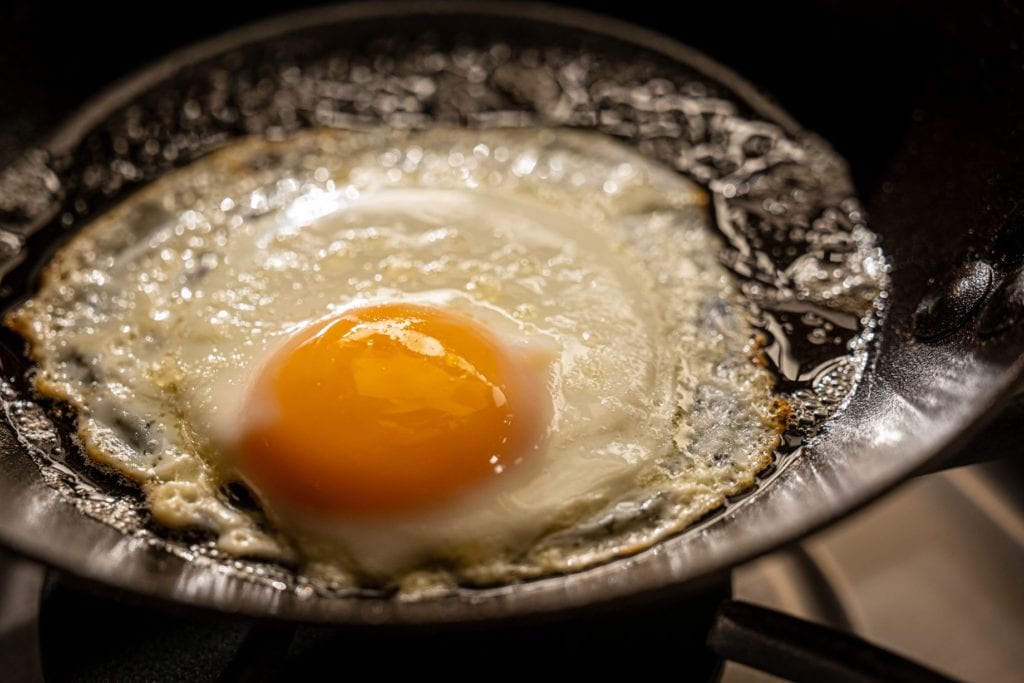
The Final Fried Eggs
A vast majority of the recipes for over-easy, sunny-side-up fried eggs, including my own up to now, make very vague references to heat. If doneness is key (and it is for lacy edges and a gooey, runny yolk), we need more precision. That's why we're going to cook our eggs over indirect heat, meaning that we're going to preheat the pan, but remove it from the heat before frying. It's the absolute best way to ensure a perfect over-easy egg. Also, use the freshest eggs you can find because they have a higher percentage of thick white albumen. Last thing: If your oven is a range rather than a wall oven, do not stash the pan lid on the cooktop while the pan is heating or it might get hot itself and that could overcook the eggs. (No, I’m not kidding. We’re going for perfection here.)This recipe first appeared in Season 2 of Good Eats: Reloaded.

ACTIVE TIME: 5 minutes
TOTAL TIME: 35 minutes
Yield: 1 to 2 servings
Software
- 1 tablespoon unsalted butter
- 2 large eggs, cold
- Pinch kosher salt
Specialized Hardware
- 10-inch carbon steel pan with tight-fitting lid
Procedure
Grab your favorite 10-inch carbon steel pan and rummage through your pots and pans until you find a lid that fits itA lid measuring 12 inches in diameter works on mine. Next, park said skillet in the middle of your oven. Crank the oven to 450°F. When the oven says it’s reached its thermal destination, let it sit in there another half hour... just to be sure. - Meanwhile, measure the butter out onto a square of parchment about the size of a Post-It note. (To tell you the truth, I usually just use a Post-It note but, as that’s not a food grade surface, I probably shouldn’t tell you that.) In any case, you want the butter soft but not melted.
- When you know the pan is good and hot, break both eggs into a custard cup or small bowl.
- Carefully remove the pan from the oven (you’ll need a side towel, oven mitt, or pot holder) and place it on the cooktop. Do not turn on a burner; this is just a heatproof place to park the pan. Add the butter and swirl the pan to coat. As soon as the butter coats the pan, but before it has fully melted, pour the eggs into the middle of the pan, season with the salt and cover with the lid.
- Set your timer for 4 minutes...exactly 4 minutes. Oh, and warm a plate. There’s nothing worse than eggs going onto a cold plate.
When your extremely precise timing device notifies you, remove the lid and use a thin spatula to free the eggsThere’s always a tad bit of sticking around the edges. from the pan. Slide the eggs onto the warm plate and consume. - 1 egg variation: Use an 8-inch skillet with a tight-fitting lid, half a tablespoon (7 grams) of butter, a smaller pinch of salt and a 3 1/2-minute cooking time.
- A lot of eggs variation: If you want to feed more of a crowd, heat two or even three 10-inch skillets in the oven. (They’re amazingly cheap compared to other cookware, so I definitely recommend having at least three of the large ones and two of the small.) Pull out one skillet to cook two eggs at a time, then wipe out the used skillet and replace in oven to reheat while cooking with the other pan.